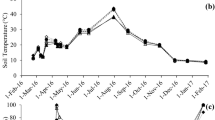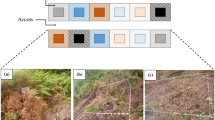Abstract
Coastal wetland loss is a major environmental issue in the Mississippi Delta region of the southern United States, where grasses such as Spartina alterniflora may play a critical role both as early colonizers on created sites and as facilitators of other marsh grasses and shrubs, particularly at high intertidal elevations. We explored the potential role of S. alterniflora as a facilitator of the colonization and growth of the shrub Baccharis halimifolia at two created wetlands in southwestern Louisiana through a combination of plant surveys and experimentation. Surveys for the presence of B. halimifolia inside and outside the bare centers of S. alterniflora clones that had begun to senesce inwardly were conducted at a 4-yr-old site originally created in 1993. The percent of clones containing B. halimifolia and the number of individual B. halimifolia plants per clone increased with increasing S. alterniflora clone size and decreased with increasing distance from an adjacent containment berm. Two experiments conducted at a second 4-yr-old site that was originally created in 1996 were designed to assess seed capture and growth of seedlings of B. halimifolia inside S. alterniflora clones. These experiments revealed that while significantly fewer seeds settle inside clones, those seedlings that grow in such areas gain a clear advantage in terms of both survival and rate of growth, which helps to explain the results of the initial survey and testifies to the role of S. alterniflora as a nurse plant in newly-created high intertidal marshes.
Similar content being viewed by others
Literature Cited
Bertness, M. D. and R. Callaway. 1994. Positive interactions in communities. Trends in Ecology and Evolution 9:191–193.
Bertness, M. D. and S. M. Yeh. 1994. Cooperative and competitive interactions in the recruitment of marsh elders. Ecology 75:2416–2429.
Bond, W. J. 1993. Keystone species. p. 237–253. In E. D. Schulze and H. A. Mooney (eds.) Ecosystem Function and Biodiversity. Springer-Verlag, Berlin, Germany.
Bourne, J. 2000. Louisiana’s vanishing wetlands. Going, going… Science 289:1860–1863.
Brooker, R. W. and T. V. Callaghan. 1998. The balance between positive and negative plant interactions and its relationship to environmental gradients: a model. Oikos 81:196–207.
Bruno, J. F. 2000. Facilitation of cobble beach plant communities through habitat modification by Spartina alterniflora. Ecology 81:1179–1192.
Callaway, R. M. and L. R. Walker. 1997. Competition and facilitation: a synthetic approach to interactions in plant communities. Ecology 78:1958–1965.
Dayton, P. K. 1972. Toward an understanding of community resilience and the potential effects of enrichment to the benthos at McMurdo Sound, Antarctica. p. 81–95. In B. C. Parker (ed.) Proceedings of the Colloquium on Conservation Problems in Antarctica. Allen Press, Lawrence, KS, USA.
Dunbar, J. B., L. D. Britsch, and E. B. Kemp. 1992. Land loss rates, report 3: Louisiana coastal plain. U.S. Army Corps of Engineers, Waterways Experiment Station, Vicksburg, MS, USA. Technical Report No. GL-90-2.
Eleuterius, L. N. 1990. Tidal Marsh Plants. Pelican Publishing Company, Gretna, LA, USA.
Greene, D. F. and E. A. Johnson. 1989. A model of wind dispersal of winged or plumed seeds. Ecology 70:339–347.
Jones, C. G., J. H. Lawton, and M. Shachak. 1994. Organisms as ecosystem engineers. Oikos 69:373–386.
Kitzberger, T., D. F. Steinaker, and T. T. Veblen. 2000. Effects of climatic variability on facilitation of tree establishment in Northern Patagonia. Ecology 81:1914–1924.
Krischik, V. A. and R. F. Denno. 1990. Differences in environmental response between the sexes of the dioecious shrub, Baccharis halimifolia (Compositae). Oecologia 83:176–181.
Matthews, G. A. and T. J. Minello. 1994. Technology and success in restoration, creation, and enhancement of Spartina alterniflora marshes in the United States. NOAA Coastal Ocean Office, Silver Spring, MD, USA. NOAA Coastal Ocean Program Decision Analysis Series No. 2.
Mitsch, W. J. and J. G. Gosselink. 1986. Wetlands. Van Nostrand Reinhold, New York, NY, USA.
Proffitt, C. E., S. E. Travis, and K. R. Edwards. 2003. Genotype and elevation influence Spartina alterniflora colonization and growth in a created salt marsh. Ecological Applications 13:180–192.
Proffitt, C. E. and J. Young. 1999. Salt marsh plant colonization, growth, and dominance on large mudflats created using dredged sediments. p. 218–228. In L. P. Rozas, J. A. Nyman, C. E. Proffitt, N. N. Rabalais, D. J. Reed, and R. E. Turner (eds.) Recent Research in Coastal Louisiana: Natural System Function and Response to Human Influences. Louisiana Sea Grant College Program, Baton Rouge, LA, USA.
Sanzone, S. and A. McElroy. 1998. Ecological impacts and evaluation criteria for the use of structures in marsh management. U.S. Environmental Protection Agency, Washington, DC, USA. EPA-SAB-EPEC-98-003.
Shumway S. W. and M. D. Bertness. 1994. Patch size effects on marsh plant secondary succession. Ecology 75:564–568.
SPSS. 1997. Systat 7.0 for Windows. SPSS Inc., Chicago, IL, USA.
Tiner, R. W., Jr. 1987. A Field Guide to Coastal Wetland Plants of the Northeastern United States. University of Massachusetts Press, Amherst, MA, USA.
U.S. Army Corps of Engineers. 2001. Beneficial Use of Dredged Material Monitoring Program 2000 Annual Report: Results of Monitoring the Beneficial Use of Dredged Material at the Calcasieu River and Pass, Louisiana. U.S. Army Corps of Engineers, New Orleans, LA, USA.
Wells, B. W. 1928. Plant communities of the coastal plain of North Carolina and their successional relations. Ecology 9:230.
Westman, W. E., F. D. Panetta, and T. D. Stanley. 1975. Ecological studies on reproduction and establishment of the woody weed, groundsel bush (Baccharis halimifolia L.: Asteraceae). Australian Journal of Agricultural Research 26:855–870.
Wilson, J. B. and A. D. Q. Agnew. 1992. Positive feedback switches in plant communities. Advances in Ecological Research 23:263–336.
Author information
Authors and Affiliations
Corresponding author
Rights and permissions
About this article
Cite this article
Egerova, J., Proffitt, C.E. & Travis, S.E. Facilitation of survival and growth of Baccharis halimifolia L. by Spartina alterniflora Loisel. In a created Louisiana salt marsh. Wetlands 23, 250–256 (2003). https://doi.org/10.1672/4-20
Received:
Revised:
Accepted:
Issue Date:
DOI: https://doi.org/10.1672/4-20




